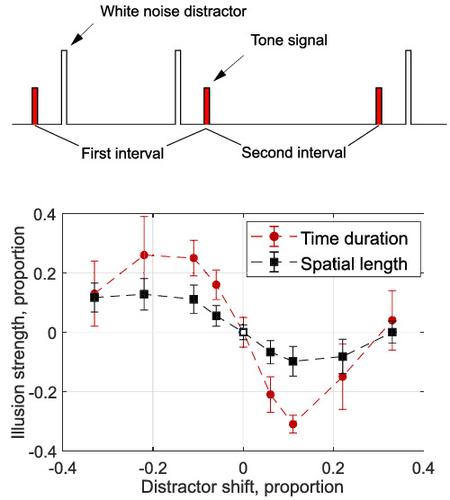当前位置:
X-MOL 学术
›
Eur. J. Nerosci.
›
论文详情
Our official English website, www.x-mol.net, welcomes your feedback! (Note: you will need to create a separate account there.)
An auditory time perception illusion analogous to the visual Müller-Lyer illusion
European Journal of Neroscience ( IF 3.4 ) Pub Date : 2021-09-15 , DOI: 10.1111/ejn.15459 Tadas Surkys 1
European Journal of Neroscience ( IF 3.4 ) Pub Date : 2021-09-15 , DOI: 10.1111/ejn.15459 Tadas Surkys 1
Affiliation

|
According to the centroid hypothesis, the visual Müller-Lyer-type illusions in which subjects misperceive lines or gaps as longer or shorter depending on surrounding distracters result from the pooling of positioning neural signals such that the perceived object is shifted towards these distracters. However, it is uncertain if this type of pooling is a more general principal that influences perceptions in other sensory modalities, including time perception based on auditory signals. In this study, I show that by applying the principles of the centroid hypothesis, an audial time duration illusion can be constructed. The perception of two sequential time intervals, which were defined by three short tone signals, was distorted by placing distracting white noise sounds near each signal. Misperception magnitude, which peaked at 31%, changed with the time interval between the tone signals and distracters; the relationship between the target–distracter distance and the illusion strength closely paralleled with that of a Müller-Lyer-type illusion, whereby the visual objects were analogically arranged in space rather than time. These results demonstrate that even if signals and distracters are distinguishable, the neural mechanisms for estimating time duration utilize coarser sampling to preserve processing resources at the expense of high accuracy. I hypothesize that systems that are dedicated to visual length and time duration estimations are based on similar perceptual magnitude evaluation algorithms. Moreover, this signal pooling principle may be applicable to other perceptual modalities across different species.
中文翻译:

类似于视觉 Müller-Lyer 错觉的听觉时间感知错觉
根据质心假设,视觉上的 Müller-Lyer 型错觉,其中受试者根据周围干扰物将线条或间隙误认为更长或更短,这是由于定位神经信号的汇集导致感知对象向这些干扰物移动。然而,不确定这种类型的汇集是否是影响其他感官方式感知的更普遍的原理,包括基于听觉信号的时间感知。在这项研究中,我表明通过应用质心假设的原则,可以构建听觉持续时间错觉。由三个短音信号定义的两个连续时间间隔的感知通过在每个信号附近放置分散注意力的白噪声声音而失真。错觉幅度,峰值为 31%,随着音调信号和干扰信号之间的时间间隔而变化;目标-干扰物距离和错觉强度之间的关系与 Müller-Lyer 型错觉的关系密切相关,其中视觉对象以类比方式排列在空间而不是时间中。这些结果表明,即使信号和干扰因素是可区分的,估计持续时间的神经机制也会利用更粗略的采样以牺牲高精度为代价来保护处理资源。我假设专门用于视觉长度和持续时间估计的系统基于类似的感知幅度评估算法。此外,这种信号池原理可能适用于不同物种的其他感知方式。目标-干扰物距离和错觉强度之间的关系与 Müller-Lyer 型错觉的关系密切相关,其中视觉对象以类比方式排列在空间而不是时间中。这些结果表明,即使信号和干扰因素是可区分的,估计持续时间的神经机制也会利用更粗略的采样以牺牲高精度为代价来保护处理资源。我假设专门用于视觉长度和持续时间估计的系统基于类似的感知幅度评估算法。此外,这种信号池原理可能适用于不同物种的其他感知方式。目标-干扰物距离和错觉强度之间的关系与 Müller-Lyer 型错觉的关系密切相关,其中视觉对象以类比方式排列在空间而不是时间中。这些结果表明,即使信号和干扰因素是可区分的,估计持续时间的神经机制也会利用更粗略的采样以牺牲高精度为代价来保护处理资源。我假设专门用于视觉长度和持续时间估计的系统基于类似的感知幅度评估算法。此外,这种信号池原理可能适用于不同物种的其他感知方式。视觉对象以类比方式排列在空间而不是时间中。这些结果表明,即使信号和干扰因素是可区分的,估计持续时间的神经机制也会利用更粗略的采样以牺牲高精度为代价来保护处理资源。我假设专门用于视觉长度和持续时间估计的系统基于类似的感知幅度评估算法。此外,这种信号池原理可能适用于不同物种的其他感知方式。视觉对象以类比方式排列在空间而不是时间中。这些结果表明,即使信号和干扰因素是可区分的,估计持续时间的神经机制也会利用更粗略的采样以牺牲高精度为代价来保护处理资源。我假设专门用于视觉长度和持续时间估计的系统基于类似的感知幅度评估算法。此外,这种信号池原理可能适用于不同物种的其他感知方式。估计持续时间的神经机制利用更粗略的采样以牺牲高精度为代价来保护处理资源。我假设专门用于视觉长度和持续时间估计的系统基于类似的感知幅度评估算法。此外,这种信号池原理可能适用于不同物种的其他感知方式。估计持续时间的神经机制利用更粗略的采样以牺牲高精度为代价来保护处理资源。我假设专门用于视觉长度和持续时间估计的系统基于类似的感知幅度评估算法。此外,这种信号池原理可能适用于不同物种的其他感知方式。
更新日期:2021-10-20
中文翻译:

类似于视觉 Müller-Lyer 错觉的听觉时间感知错觉
根据质心假设,视觉上的 Müller-Lyer 型错觉,其中受试者根据周围干扰物将线条或间隙误认为更长或更短,这是由于定位神经信号的汇集导致感知对象向这些干扰物移动。然而,不确定这种类型的汇集是否是影响其他感官方式感知的更普遍的原理,包括基于听觉信号的时间感知。在这项研究中,我表明通过应用质心假设的原则,可以构建听觉持续时间错觉。由三个短音信号定义的两个连续时间间隔的感知通过在每个信号附近放置分散注意力的白噪声声音而失真。错觉幅度,峰值为 31%,随着音调信号和干扰信号之间的时间间隔而变化;目标-干扰物距离和错觉强度之间的关系与 Müller-Lyer 型错觉的关系密切相关,其中视觉对象以类比方式排列在空间而不是时间中。这些结果表明,即使信号和干扰因素是可区分的,估计持续时间的神经机制也会利用更粗略的采样以牺牲高精度为代价来保护处理资源。我假设专门用于视觉长度和持续时间估计的系统基于类似的感知幅度评估算法。此外,这种信号池原理可能适用于不同物种的其他感知方式。目标-干扰物距离和错觉强度之间的关系与 Müller-Lyer 型错觉的关系密切相关,其中视觉对象以类比方式排列在空间而不是时间中。这些结果表明,即使信号和干扰因素是可区分的,估计持续时间的神经机制也会利用更粗略的采样以牺牲高精度为代价来保护处理资源。我假设专门用于视觉长度和持续时间估计的系统基于类似的感知幅度评估算法。此外,这种信号池原理可能适用于不同物种的其他感知方式。目标-干扰物距离和错觉强度之间的关系与 Müller-Lyer 型错觉的关系密切相关,其中视觉对象以类比方式排列在空间而不是时间中。这些结果表明,即使信号和干扰因素是可区分的,估计持续时间的神经机制也会利用更粗略的采样以牺牲高精度为代价来保护处理资源。我假设专门用于视觉长度和持续时间估计的系统基于类似的感知幅度评估算法。此外,这种信号池原理可能适用于不同物种的其他感知方式。视觉对象以类比方式排列在空间而不是时间中。这些结果表明,即使信号和干扰因素是可区分的,估计持续时间的神经机制也会利用更粗略的采样以牺牲高精度为代价来保护处理资源。我假设专门用于视觉长度和持续时间估计的系统基于类似的感知幅度评估算法。此外,这种信号池原理可能适用于不同物种的其他感知方式。视觉对象以类比方式排列在空间而不是时间中。这些结果表明,即使信号和干扰因素是可区分的,估计持续时间的神经机制也会利用更粗略的采样以牺牲高精度为代价来保护处理资源。我假设专门用于视觉长度和持续时间估计的系统基于类似的感知幅度评估算法。此外,这种信号池原理可能适用于不同物种的其他感知方式。估计持续时间的神经机制利用更粗略的采样以牺牲高精度为代价来保护处理资源。我假设专门用于视觉长度和持续时间估计的系统基于类似的感知幅度评估算法。此外,这种信号池原理可能适用于不同物种的其他感知方式。估计持续时间的神经机制利用更粗略的采样以牺牲高精度为代价来保护处理资源。我假设专门用于视觉长度和持续时间估计的系统基于类似的感知幅度评估算法。此外,这种信号池原理可能适用于不同物种的其他感知方式。


























 京公网安备 11010802027423号
京公网安备 11010802027423号